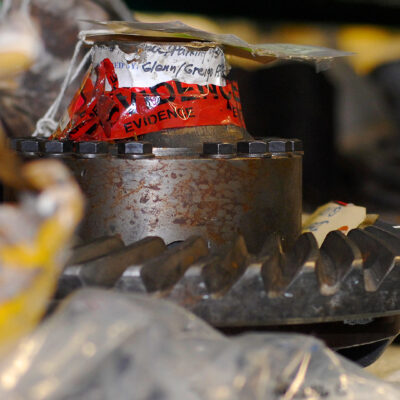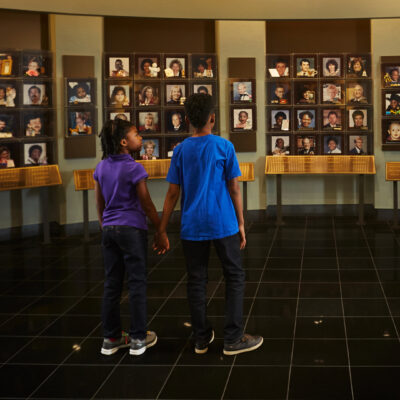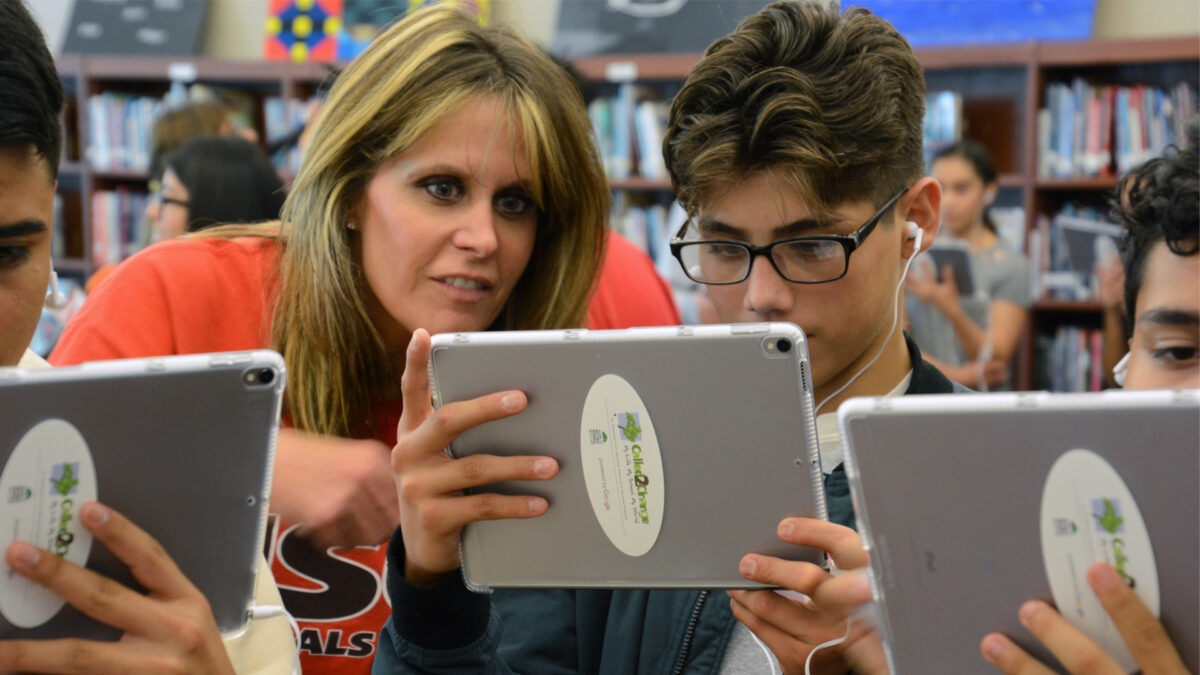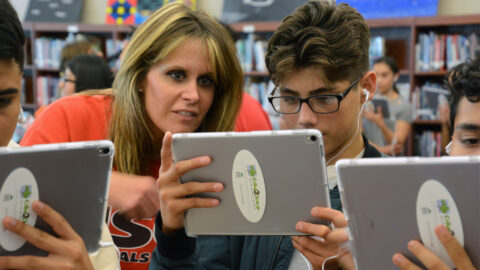Lesson Plan
Does Violence Solve Problems?
The first few days of the Oklahoma City bombing could be characterized using thousands of different words; however, the survivors’ statements of this devastating experience give the best perspective. For instance, during the McVeigh trial in 1997, former Marine Corps recruiter Michael Norfleet, who worked on the sixth floor of the Federal building when the bomb exploded, recalled, “About the time I got ‘Hello’ and ‘Good morning’ out of my mouth, the bomb hit … All I remember is following the blood trail from somebody before me.”
Several key events took place that led authorities to arrest the persons responsible for this tragedy. No word in the English language could truly describe the scene in downtown Oklahoma City. The media described it as, terrorism, and an evil act that could only be planned by the most criminal mind. As chaotic as the first days of the Oklahoma City bombing were, brave men and women were charged with the responsibility of making sense of a senseless act. Organizations such as the FBI played a critical role in gathering information and investigating every lead. The public also played an important role in solving this crime against humanity. Analysts were able to link the evidence found to the perpetrators of the bombing.
Lesson Summary
Students will analyze, summarize, and synthesize the first days of the Oklahoma City bombing.
- Essential Questions: Does violence solve problems?
- Time frame: 2-3 class periods
- Subject(s): Social Studies, English
Materials Needed
- Pencil
- Notebook Paper
- Scenario Sheet
- First Day Card Sort
- Frayer Model (Blank for students)
- Frayer Model OKC example (Teachers use this as the model for Frayer Model)
Teacher Tip: Make more than one copy of anything you model so kids can pass it around and get a closer look. This allows visual and kinesthetic students to pay more attention to the model.
Lesson
Students will read a quote and answer if it is always, sometimes or never true.
- Students will read a quote by Mahatma Gandhi which states, “An eye for an eye leaves the world blind.”
- Now, the student must choose the answer that best describes how often the statement is true: always, sometimes or never true.
- After each answer, the students will write a short justification regarding their response.
- Students can participate in a whole-class discussion or share out their responses.
Students will create their own definition of terrorism using the Frayer Model.
- Invite students to create their own definitions of terrorism. Have them write this down a sheet of notebook paper.
- Students will then read the “Defining Terrorism” section in the handout.
- Students will then separate a page into four quadrants by drawing one horizontal line and one vertical line (essentially drawing a full-page plus sign) with an oval in the center.
- They label quadrants as follows (beginning from the upper-left quadrant moving clockwise): definition, characteristics, examples, non-examples.
- Students will then write Terrorism in the center oval of the graphic organizer.
- Students may use their own definition of terrorism or add new information to their definition after they have read the section.
Teacher Tip: Be sure students do not copy the definition from the reading section. If your students are struggling, you can model how to complete the Frayer Model with a more familiar concept such as the Oklahoma City Thunder.
7. Once the model is complete, let the students share their ideas with a partner or group, modifying their diagrams as they accept new information.
Students will read the section “Understanding the Federal Bureau of Investigation.”
- Individually, students generate the four most important ideas of the text on their own.
- Students will then pair up to share their ideas and agree on the two most important ideas from their lists.
- Pairs are paired into groups of four.
- Each group must agree on the single most important idea.
- Students free-write independently about the most important idea for 3-5 minutes, explaining what they know well enough that someone who has never heard the idea could understand it.
- Students return to their groups and participate in a class discussion of the big idea.
Students will complete a card sort using the Investigation Timeline.
- Students will use the Investigation Timeline for this assignment.
- Have students divide into groups or pairs.
- Each date on the timeline will act as a category for the events that took place.
- Students must use the timeline to put the correct events with correct dates and determine which events came first.
- Students should be encouraged to lay out each card in a row or column under the category headers so it is easy to see how they sorted each item.
- Student groups must come to a common agreement on which category to place each card before sorting a new one.
- Have the groups share out where they sorted each card and why.
Students will create their own responses to conflicts using the information we learned in the lesson.
- Students will now respond again to the quote, “An eye for an eye leaves the whole world blind.”
- With this quote written on the board, show students pictures of the devastation and the victims affected by Timothy McVeigh’s decision to carry out his own brand of justice.
- Show a short clip (2-4 minutes) of individuals impacted by the bombing talking about how their lives have forever been changed.
- Allow students 1-2 minutes to discuss the consequences of McVeigh’s actions.
- Students will then participate in “What will I do now?” Use the scenarios sheet and cut each scenario into a small tab.
Teacher Tip: You may need to make copies, as it is alright for a class to have duplicates. - Now, put the tabs into a small box with only the top open. For example, an empty tissue box would work perfectly for this assignment.
- Once students have picked their scenario, prompt the students to come up with a peaceful solution to the scenario. You may also allow students to choose their scenarios in groups.
- Students have 5 minutes to explain their responses.
- Once everyone has completed this assignment, students may share their responses with the classroom (optional).
First Days Card Sort
Directions: Teachers should cut each square out. Each group needs a full page, pre-cut by the teacher. Students will match the dates with the correct events that took place on that day. This should help students have an idea of the concept of cause and effect, how events throughout history are precipitated by causes, and how they also have effects of their own – on other events and on the time period itself.
okcm-c2c-lesson-plan-first-days-card-sortStudent Scenario Sheet
Directions: Teachers should cut each square out. These scenarios should be placed in a box; furthermore, walk around the classroom with the box and allow each student to reach in and choose a random scenario. Students must then write a peaceful solution to this scenario. You may need more than one copy for a large class.
okcm-c2c-lesson-plan-student-scenario-sheetOklahoma History 5.10 Cite specific textual and visual evidence to analyze the causes and effects of the domestic terrorist attack on the Murrah P. Federal Building in Oklahoma City including the responses of Oklahomans to the event, the concept of the Oklahoma Standard and the creation of the Oklahoma City National Memorial & Museum.
English Standard 9.3.W.5 Students will show relationships among the claim, reasons, and evidence and include a conclusion that follows logically from the information presented and supports the argument.
NCSS Standards D4.2.6-8. Construct explanations using reasoning, correct sequence, examples, and details with relevant information and data, while acknowledging the strengths and weaknesses of the explanations.
Always, Sometimes, Never True – Keeley, P., & Tobey, C. R. (2011). Get the facts. In Mathematics Formative Assessment: 75 Practical Strategies for Linking Assessment, Instruction, and Learning (pp. 57-59). Thousand Oaks, CA: Corwin, SAGE.
Card Sort – Keeley, P. (2008). Science formative assessment: 75 practical strategies for linking assessment, instruction, and learning. Thousand Oaks, CA: Corwin, SAGE.
Frayer Model – Keeley, P. (2008). Science formative assessment: 75 practical strategies for linking assessment, instruction, and learning. Thousand Oaks, CA: Corwin, SAGE.







